Introduction
Scalp is the soft tissue that covers the vault of the skull. It extends:
- Anteriorly: Supraorbital margin
- Laterally : Superior temporal lines
- Posteriorly: External occipital protuberance and superior nuchal lines.
Enumerate the layers of Scalp.
The scalp consists of five layers. Superficial three are intimately bound together and move as one unit. The five layers from superficial to deep are:
- S- Skin: It is thick and has large number of hair follicles and associated sebaceous glands. Therefore, scalp is the commonest site of sebaceous cysts.
- C – Connective tissue (Superficial fascia) It is composed of dense connective tissue that binds the skin to the underlying aponeurosis of occipitofrontalis muscle. Fibrous septa break up this layer into numerous small pockets containing lobules of fat. The named blood vessels and nerves of the scalp are located in this layer and the walls of the blood vessels are adherent to the fibrous network, therefore in case due to injury, if the blood vessels are torn or cut, the walls are unable to retract and this causes profuse bleeding.
- A- Aponeurosis (Epicranial aponeurosis): It is composed of occipitofrontalis muscle and its aponeurosis. The aponeurosis of occipitofrontalis muscle is also called epicranial aponeurosis or galea aponeurotica (Latin: galea = helmet). The wounds of the scalp gape if epicranial aponeurosis is cut transversely because the aponeurosis is pulled in the anteroposterior direction by the tone of occipitofrontalis muscle.
- L- Loose areolar tissue: It is made up of loose areolar tissue. It is traversed by emissary veins which connect the veins in the second layer of scalp with intracranial dural venous sinuses. It acts as a natural plane of cleavage during craniotomy. It is also known as the ‘dangerous layer of scalp’.
- P –Pericranium: It is composed of the periosteum of bones of vault of skull. It is loosely connected to the underlying bones and can be easily stripped except at sutures, where it is connected to the endocranium via sutural ligaments.
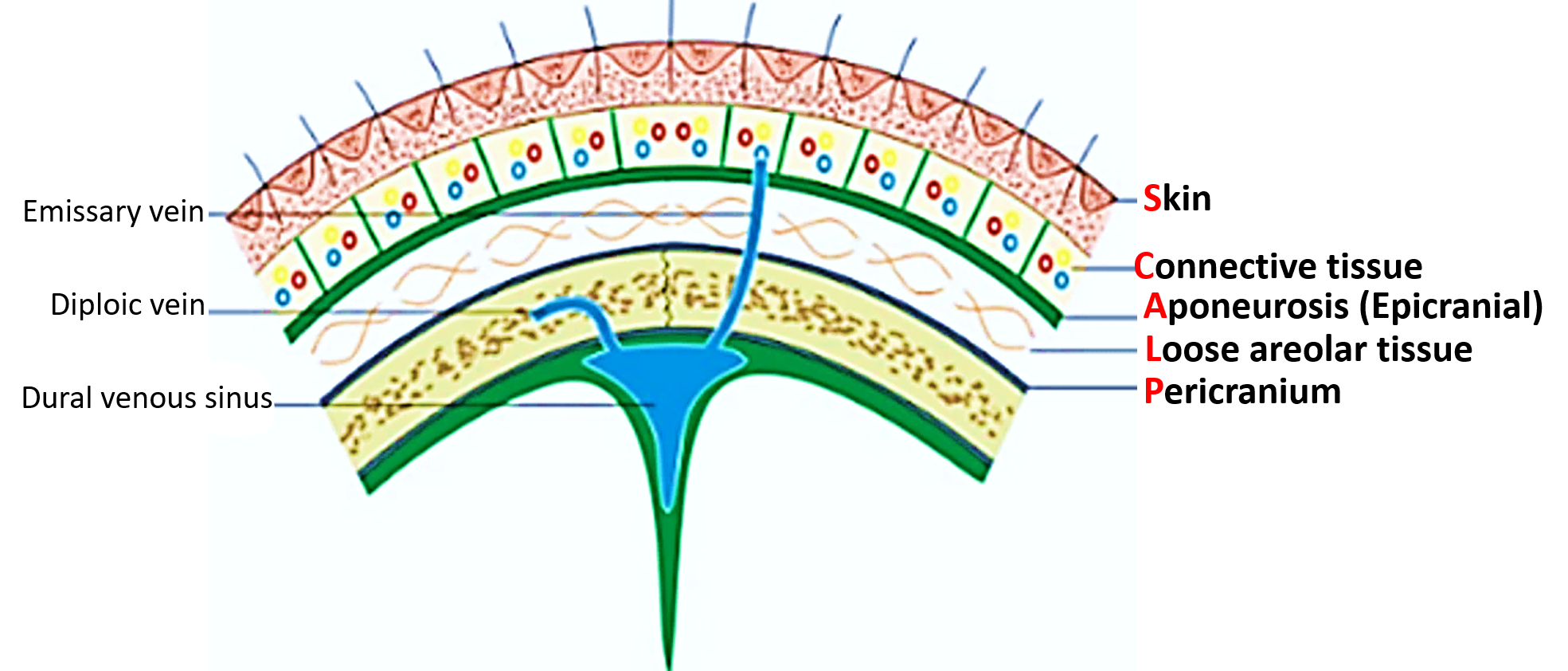
Name the arteries that supply Scalp.
Scalp has a rich blood supply from the branches of internal and external carotid arteries. There is rich anastomosis between the branches of two sides and branches of internal and external carotid arteries of the same side.
There are five arteries on each side, three in front of the auricle and two behind the auricle. The arteries are:
Three in front of the auricle:
- Supratrochlear and Supraorbital (branches of internal carotid artery)
- Superficial temporal (branch of external carotid artery)
Two behind the auricle:
- Posterior auricular and Occipital (branches of external carotid artery)
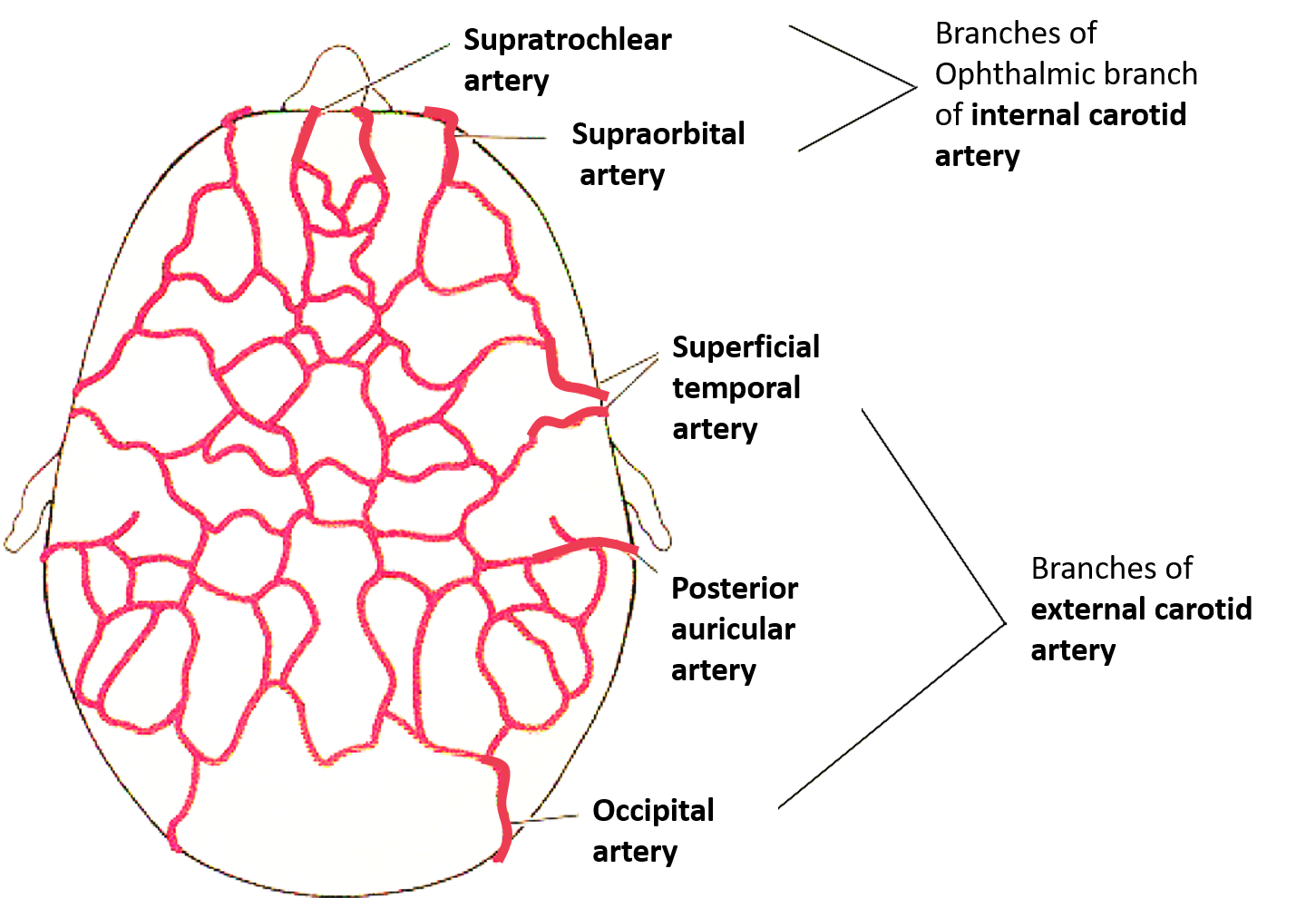
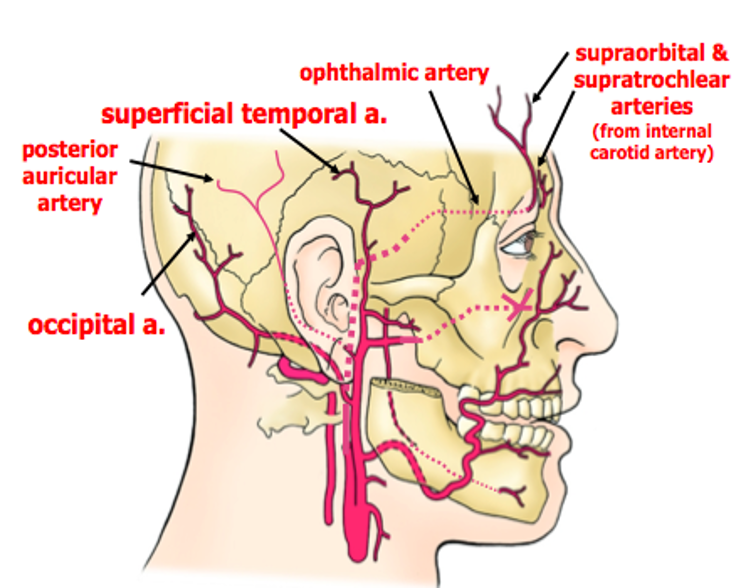
Name the nerves that innervate Scalp.
Scalp on either side of the midline is supplied by
- 8 sensory nerves: 4 in front of the auricle and 4 behind the auricle.
- 2 motor nerves: 1 in front of the auricle and 1 behind the auricle.
The nerves in front of the auricle are branches of the three subdivisions of trigeminal nerve ie. ophthalmic, maxillary and mandibular. Those behind the auricle arise from the second and third cervical nerves (C1 spinal nerve has no cutaneous branch).
Sensory nerves of the scalp
| In front of the auricle | Behind the auricle |
|---|---|
| Supratrochlear (from ophthalmic division of trigeminal nerve | Great auricular (from ventral rami of C2-C3 spinal nerves) |
| Supraorbital (from ophthalmic division of trigeminal nerve) | Lesser occipital from ventral ramus of C2 spinal nerve) |
| Zygomaticotemporal (from maxillary division of trigeminal nerve | Greater occipital (from dorsal ramus of C2 spinal nerve) |
| Auriculotemporal (from mandibular division of trigeminal nerve) | Third occipital (from dorsal ramus of C3 spinal nerve) |
Motor supply of Scalp
| Muscle | Location | Nerve supply |
|---|---|---|
| Occipital bellies of occipitofrontalis muscle | Behind the auricle | Posterior auricular branch of facial nerve |
| Frontal bellies of occipitofrontalis muscle | In front of the auricle | Temporal branch of facial nerve |
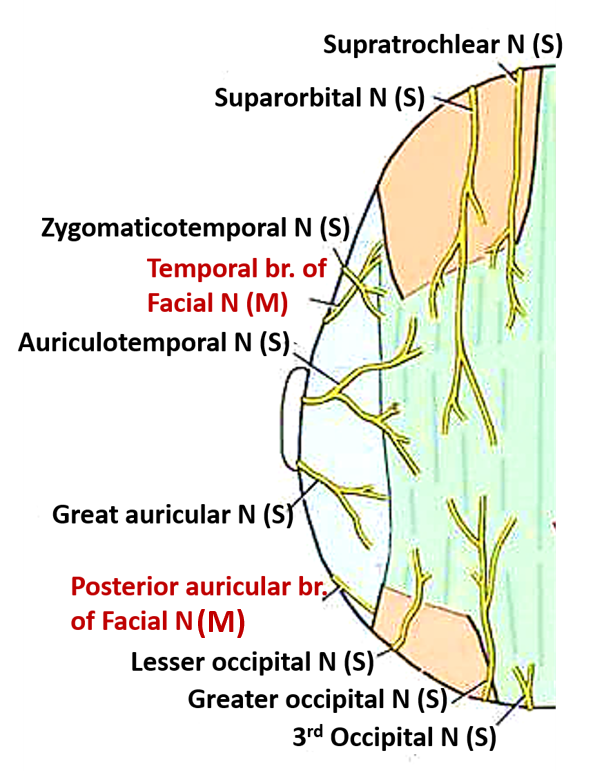
Write in a tabulated form the origin, insertion, action and nerve supply of Occipitofrontalis Muscle.
Occipitofrontalis muscle consists of a pair of occipital bellies (posteriorly) and a pair of frontal bellies (anteriorly). Both the parts are inserted into the intervening galea aponeurotica or epicranial aponeurosis.
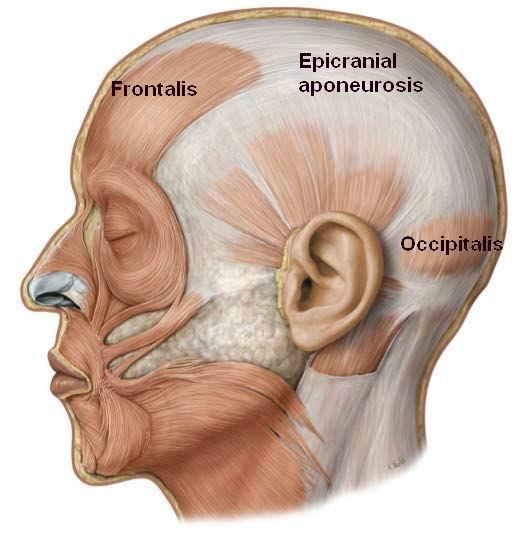
| Muscle | Origin | Insertion | Nerve supply | Action |
|---|---|---|---|---|
| Occipital bellies of occipitofrontalis muscle | Lateral 2/3 rd of superior nuchal lines of occipital bone | Into epicranial aponeurosis | Posterior auricular branch of facial nerve | Alternate contraction of occipitalis and frontalis move the scalp backward and forward |
| Frontal bellies of occipitofrontalis muscle | Skin and subcutaneous tissue over the eyebrows and root of nose | Into epicranial aponeurosis | Temporal branch of facial nerve | Frontal bellies raise the eyebrows as in surprise. |
Applied Aspects
Deep transverse wounds of scalp tend to gape
In deep wounds of scalp if the epicranial aponeurosis is cut transversly the wounds tend to gape because the aponeurosis is under tension in anteroposterior direction due to the tone of occipitofrontalis muscle. If the wound cuts the aponeurosis in antereoposterior direction, it will not gape.
Scalp wounds bleed profusely
The scalp has rich blood supply and the walls of the blood vessels are adherent to the fibrous network as they pass in the second layer of the scalp. Therefore, when the blood vessels are torn or cut, they are unable to retract and cause profuse bleeding.
Fourth layer of scalp (loose areolar tissue) is known as ‘dangerous layer of scalp’.
The subaponeurotic loose areolar connective tissue layer is known as dangerous layer of scalp because the blood and pus tend to collect in this layer and as it contains the emissary veins ( which connect veins of scalp to intracranial dural venous sinuses), the infection from this layer may travel readily along the emissary veins into the intracranial venous sinuses.
A blow on head may cause ‘Black Eye”
A blow on head leads to collection of blood in the 4th layer (loose areolar tissue) of scalp. The blood from this layer may gravitate into the eyelids because the frontalis muscle has no bony attachment. This leads to formation of hematoma and black discoloration of skin around the eyes few hours after the head injury resulting in a condition called ‘black eye’. The blood cannot pass laterally or posteriorly due to the attachment of epicranial aponeurosis and occipitalis muscle to the superficial temporal lines and superior nuchal lines respectively.
Safety valve hematoma
In children the fracture of cranial vault may be accompanied by torn dura mater and pericranium. In such cases the blood from intracranial hemorrhage escapes into the subaponeurotic/fourth layer of the scalp through the fracture lines. As a result, the signs of cerebral compression are not seen until the subaponeurotic space is completely full of blood. Because of this the collection of blood in the fourth layer is referred to as a safety valve hematoma.
Cephalhematoma
Accumulation of blood deep to the pericranium/periosteal layer of scalp due to injury is known as cephalhematoma. The swelling is localized over the particular bone and takes the shape of the bone involved, because the pericranium is loosely attached over the bones except at the sutural lines where it is connected to the endosteum via sutural ligaments. The hematoma is bound by suture lines and the swelling has well-defined margins. Cephalhematoma is often seen in the parietal region. It may take 4-7 days to disappear.
Caput succedaneum: It is a collection of fluid in the loose areolar tissue/fourth layer of the scalp. The swelling is diffuse, crosses the sutures and the midlne and is over the presenting part of the head at delivery. It occurs due to obstruction of venous return of scalp during the passage of head via the birth canal. Usually the edema subsides in 24-48 hrs.

Good. Want more question and answers in abdomen.
Good page add more MBBS stuff
so touching notes and explanations i ever seen
Very helpful website best for medical students
Very nice text .Easy to read
Anatomy made easy
It has really educative and inspiring
Very impressed
natomy QA is a very helpful website where you will get easy articles related to anatomy. I always visit this site to learn about anatomy-related queries.
Thanks
Very useful